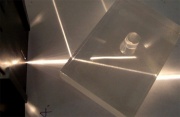Difference between revisions of "Perspex"
Jump to navigation
Jump to search
m (Text replace - "\[http:\/\/cameo\.mfa\.org\/materials\/fullrecord\.asp\?name=([^\s]+)\s(.*)\]" to "$2") |
|||
| (6 intermediate revisions by the same user not shown) | |||
| Line 2: | Line 2: | ||
== Description == | == Description == | ||
| − | [ICI, England] A trademark for transparent acrylic sheeting made from polymethyl methacrylate. The equivalent U.S. material is sold as [[Plexiglas | + | [ICI, England] A trademark for transparent acrylic sheeting made from [[polymethyl methacrylate]]. The equivalent U.S. material is sold as [[Plexiglas|Plexiglas®]]. |
| − | == | + | == Physical and Chemical Properties == |
| − | Can be electrostatic. More easily scratched than glass. | + | * Can be electrostatic. |
| + | * More easily scratched than glass. | ||
| − | == | + | == Resources and Citations == |
| − | + | * 3A Composites: [https://www.perspex.com/ Perspex ] | |
| − | |||
| − | |||
| − | |||
* G.S.Brady, ''Materials Handbook'', McGraw-Hill Book Co., New York, 1971 Comment: p. 11 | * G.S.Brady, ''Materials Handbook'', McGraw-Hill Book Co., New York, 1971 Comment: p. 11 | ||
| Line 20: | Line 18: | ||
* Marie Svoboda, Conservation Survey Index, unpublished, 1997 | * Marie Svoboda, Conservation Survey Index, unpublished, 1997 | ||
| − | * Wikipedia | + | * Wikipedia: http://en.wikipedia.org/wiki/Perspex (Accessed Nov. 9, 2005) |
| − | [[Category:Materials database]] | + | [[Category:Materials database]][[Category:MWG]][[Category: Board/Panel, Plastic]][[Category:Glazing]] |
Latest revision as of 09:39, 4 March 2023
Description
[ICI, England] A trademark for transparent acrylic sheeting made from Polymethyl methacrylate. The equivalent U.S. material is sold as Plexiglas®.
Physical and Chemical Properties
- Can be electrostatic.
- More easily scratched than glass.
Resources and Citations
- 3A Composites: Perspex
- G.S.Brady, Materials Handbook, McGraw-Hill Book Co., New York, 1971 Comment: p. 11
- Hermann Kuhn, Conservation and Restoration of Works of Art and Antiquities, Butterworths, London, 1986
- Marie Svoboda, Conservation Survey Index, unpublished, 1997
- Wikipedia: http://en.wikipedia.org/wiki/Perspex (Accessed Nov. 9, 2005)
